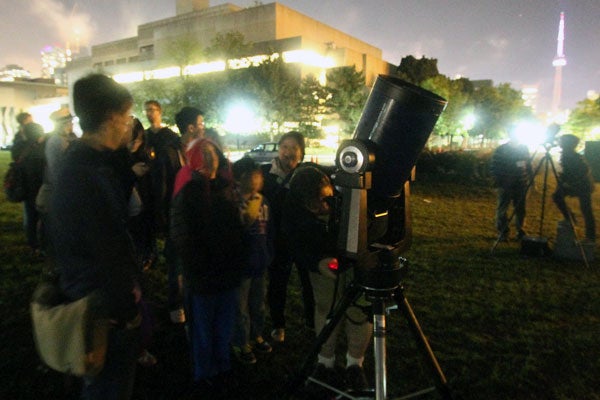
From the ocean to the stars: Toronto Science Festival
Published: October 24, 2013
Thousands took in a new event on Toronto’s cultural calendar recently—a three-day celebration of science, organized by the University of Toronto, the Toronto Science Festival.
The festival explored the intriguing theme of Life in the Universe through keynote talks, panel discussions, film screenings, live music and dance performances, microscope and telescope observing sessions, a Café Scientifique “Brunch-with-a-Scientist”, and more.
“The goal of the festival was to engage the public with science, scientists and big ideas,” said Ray Jayawardhana, senior advisor to the U of T president on Science Engagement and a key organizer of the festival. “Our goal was to reach, not just people who were already interested in science, but those who may never have been to a science talk or science event before.”
The theme brought together scientists from a variety of disciplines, including palaeontology, evolutionary biology, geochemistry, astronomy, planetary science, anthropology, oceanography and astrobiology. These experts, from the U of T and around North America, explored the origin and evolution of life on Earth, life in extreme environments, and life beyond our planet.
Canadian astronaut and U of T alumna Julie Payette received a warm and enthusiastic greeting on Friday evening in Convocation Hall as she kicked off the festival with a talk about the human exploration of space. Payette charmed the audience with her stories, and described how, as a young girl in Quebec, she was inspired to be an astronaut by watching the Apollo moon landings on television.
Evolutionary biologist and “evo-devo” pioneer Sean Carroll followed Payette with a fascinating talk titled “Brave Genius” that wove together the stories of biologist Jacques Monod, philosopher Albert Camus, the French Resistance in World War II, and the emerging science of evolutionary development.
And a third keynote lecture featured Mars Rover imaging scientist Jim Bell who took the Convocation Hall audience on a virtual tour of the surface of the Red Planet. He described Mars by saying “It is stark. It is evocative. It is extreme.” And his images—some received from the Curiosity Rover just days before the festival—attested to that depiction.
On Saturday, a panel of scientists engaged in a lively discussion about the origins and evolution of life on Earth—a discussion which spanned the fossil record, the idea that “humans are the sixth largest extinction event to happen to life on Earth”, and how evolution informs our search for life beyond our planet.
Another panel explored the topic of extreme environments on Earth where we find life, such as hydro-thermal vents on the deep ocean floor, in the Earth’s crust kilometres below the surface and elsewhere in our Solar System.
A highlight for many festival-goers was a third panel and two additional events on Sunday that all featured astronomer Jill Tarter, a pioneer in the Search for Extraterrestrial Intelligence, or SETI, who inspired the character played by Jodie Foster in the movie Contact.
She attracted many excited fans during the festival’s Café Scientifique “Brunch-with-a-Scientist”, SETI panel, and special screening of Contact. After the film she talked about the making of the film.
“No, you don’t use walkie-talkies near a radio telescope like in the movie," Tarter said. "A walkie-talkie on the moon would be the second brightest radio source in the sky.”
(Read a complete list of speakers and panellists.)
The variety of events in the program attracted a broad audience. The progressive dance company inDance performed a new piece inspired by the festival theme. And singer-songwriter-physicist Diane Nalini serenaded her audience with songs like Love in Outer Space, which Diane was inspired to write after watching Contact.
A late-night Star Trek Half-Marathon explored Life in the Universe through the lens of the science fiction TV franchise. Dunlap Institute astronomer Michael Reid and Hugo-Award-winning author Peter Watts led the lively discussion that followed the screening of three different episodes.
As part of the festival, members of the public were invited to submit messages they would send to intelligent extraterrestrial beings. The three winning messages were announced during the festival and the messages transmitted via the Algonquin Radio Observatory in Algonquin Park to two stars with known planetary systems.
Sami Houry from Calgary thought we should send a signal that conveyed the Golden Ratio of 1.618. Chelsea Humphries, 20, a U of T student, wondered whether aliens were like humans, “paradoxical and imperfect creatures.” And Hamish Tough, 8, from Fort McMurray, tried to relate to extraterrestrials through the things that were important to him: “I like to play hockey…please tell me about the games you play.”
Reid, who is also director of Public Outreach for the Dunlap Institute and was another key organizer of the festival, measured the event’s success in many ways.
“We reached the thousands who attended, which is great. But we also engaged individuals like eight-year-old Hamish Tough, who I might not have reached without something like the festival,” says Reid.
“And who’s to say how the thought of his message heading to the stars will inspire Hamish? Who could’ve said how the Apollo moon landings would inspire a young Julie Payette?”
Because of the scope of the festival, many departments and institutes were involved in making it happen. It was organized by U of T Science Engagement through the Senior Advisor to the President on Science Engagement and by the Dunlap Institute for Astronomy & Astrophysics, together with Faculty of Arts & Science academic units and administrative offices, including:
- Department of Astronomy & Astrophysics
- Department of Cell & Systems Biology
- Department of Earth Sciences
- Department of Ecology & Evolutionary Biology
- Canadian Institute for Theoretical Astrophysics
- Alumni Relations, Faculty of Arts & Science
- Alumni Relations, University Advancement
Partners outside the university included the Toronto Centre of the Royal Astronomical Society of Canada, the Algonquin Radio Observatory and the Ontario Science Centre.



